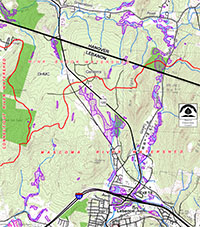Rt. 120 – Mount Support

PROTECTION OF NATURAL HABITAT in the Route 120 Corridor
The Route 120 Corridor in Lebanon and Hanover contains some astounding beauty and ruggedness, with habitats harboring an exceptional richness of wildlife.
Although commercial and residential developments are prevalent along the major roadways (Rt. 120, Greensboro Road and Great Hollow Road), the interior contains more than 500 acres of contiguous forest with diverse habitats and natural features. It is truly a unique landscape worthy of protection.
With further development slated for this growing area, many residents attended public meetings in 2007 and 2008 to expressed their desire to protect the “wild” areas in this corridor. Both Lebanon and Hanover residents voiced their support for this ecologically and geologically diverse area, and their commitment to maintaining its environmental quality.
We recognize the ecological value of the 120 Corridor, and strongly agree with the many residents committed to its protection. The Hanover Conservancy envisions the permanent conservation of this relatively wild core interior area with its diverse flora and fauna, fragile wetlands, critical wildlife corridors, and distinctive geological features. To that end, we have begun working to forge partnerships, facilitate discussions, and begin the necessary steps to make this happen for the future of our communities.
This is a unique opportunity for our two communities to work together to maintain the integrity of this special wilderness. Bears, birds and other wildlife have no concern for town boundaries as they move about the forest. Let us not limit our conservation actions by some line on a map.
THE LAND
It is remarkable that, so close to our town centers, there are lands with qualities we generally associate with much more extensive and remote wilderness. Fortunately, the ruggedness of these areas and long-term stable ownership have protected them from major disturbances in the past.
The core habitat areas of the 120 Corridor are bordered by three major roads: Rte 120, Greensboro Road and Great Hollow Road (see map). The northern part of the 120 Corridor drains to Mink Brook, the southern part to the Mascoma River, and both of these flow to the Connecticut River. This large interior forested area includes Mt. Support, Rix Ledges, many wetlands that support rare species and plant community types on a diverse terrain of large boulders and outcrops.
A network of adjacent conservation lands provides travel corridors for wildlife, and increase the conservation value of the Route 120 Corridor. These neighboring conservation lands include the Appalachian Trail, Mink Brook Nature Preserve, Greensboro Ridge Natural Area, Hypertherm Wetlands and Great Hollow Forest in Hanover, and Indian Ridge, the Landmark Tract, and Boston Lot Lake in Lebanon.
A. THE CASE FOR LAND PROTECTION:
Multiple reports (e.g., Lebanon’s Natural Resource Inventory, and work by The Nature Conservancy and NH Fish and Game) document the many wetland areas, small streams, rich deciduous forests, high quality wildlife habitat, rare plants and unusual rock formations in the Rt. 120 corridor. Noteworthy features include:
- Quality habitat and populations of bear, moose, bobcat and other mammals, characteristic of wilderness areas in New England
- Exemplary bog and acidic seepage swamp habitats
- Barrens strawberry -included on the state’s list of threatened plants
- Stream edges include hemlock talus forests and mixed hardwood deciduous forests
- Extensive forested wetlands with streams flowing north to Mink Brook
- Glacial erratics, boulder fields, ridges, rock faces and amphitheaters
- Extensive bands of maidenhair fern, rattlesnake plantain and cathedral pines.
- Examples of near-old-growth trees
Furthermore, the 2008 NH Fish and Game Department report emphasizes that land conservation efforts are critical for the significant wildlife movement that takes place in the corridor.
B. CONSERVATION PRIORITIES
The Conservancy believes that community plans must protect core natural areas, and separate these undisturbed natural areas from commercial and residential developments with adequate buffer zones. We encourage the use of “smart growth” principles which concentrate buildings near existing infrastructure and conserve open lands and access routes that minimize environmental damage. Project planning must consider these objectives.
- Core natural habitat in the 120 Corridor must be protected from disturbance and increased development. Preserve existing wildlife corridors in the interior and create new ones across roads and developed areas.
- Buffer streams to protect water quality.
- Protect Mount Support and Rix Ledges. These are important examples of geologically uplifted lands with very dramatic topography. This accentuates their remote, wild character.
- Any public access trails should be kept at a minimum and be near developments, avoiding the most sensitive lands.
C. CURRENT STATUS
The City of Lebanon has now granted approval for Phase I of development on 15 acres at the former Wilson Tire site. Conservation of lands on the Lebanon side is included in plans for a later phase that is currently contingent upon further approvals and an inter-municipal agreement to address sewerage treatment. On the Hanover side, discussions have not yet advanced.
CONCLUSION
It is essential to develop an overarching plan for future developments in the 120 Corridor. We need to think beyond our human town boundaries and avoid piecemeal development approvals to define the overall character of this unique area. The Hanover Conservancy supports the conservation of this large, core natural area while development moves forward under smart growth principles.




